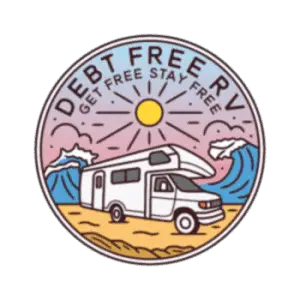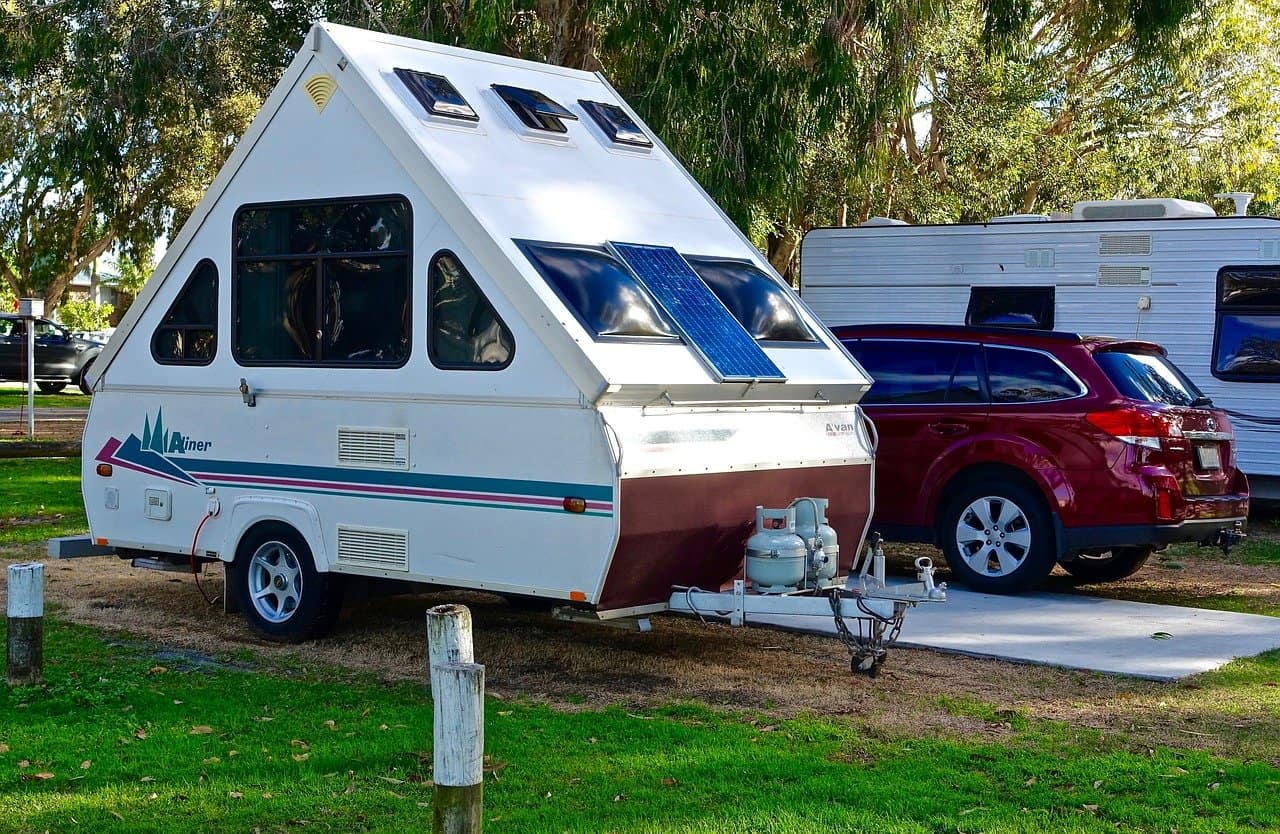As a camping enthusiast, it can be overwhelming to decide which home away from home is right for you. It’s easy to feel uncertain when it comes down to choosing between an A-Frame and a pop-up camper. So, what are the pros and cons of A-Frame and pop-up campers?
A-Frame campers have increased headroom, straightforward assembly, and durable structure. On the other hand, pop-up campers showcase a lightweight design, increased floor space, and the ability to accommodate larger groups.
This article will break down the pros and cons of A-Frame and pop-up campers. If you’re not sure which type of camper is right for you, read on to learn more about the benefits and drawbacks of each kind.
What’s the Primary Difference Between A-Frame and Pop-Up Campers?
Although their names may seem misleading, an A-Frame camper can technically be considered a type of pop-up camper. However, the differences in appearance between A-Frame campers and standard pop-up campers are pretty noticeable.
The primary difference between A-Frame and pop-up campers is their structure. Pop-up campers have canvas panels that expand both outward and upward. In contrast, A-Frame campers extend only in an upward direction.
The Pros of A-Frame Campers
A-Frame campers can be a fantastic option for a small family looking for a comfortable camping experience. Their many benefits include increased headroom, quick assembly, and durable structure, among other qualities.
Let’s take a closer look at the benefits of A-Frame campers.
A-Frame Shape Provides Headroom
One notable benefit of A-Frame campers is that they provide a little bit of extra headroom. The peaked roof structure of this type of camper often makes them feel roomier, especially in the center areas.
If you’re tall, you might feel more comfortable in an A-Frame camper than in a pop-up camper, depending on the height of the particular camper you choose.
The Frame Is Durable Yet Lightweight
Another key advantage to A-Frame campers is their durable structure. While they may seem less stable than a full-blown RV, these campers are impressively sturdy for their size and weight.
A-Frame campers are known for being lightweight, with some weighing even less than 2,000 lbs (907 kg). With this in mind, A-Frame campers are an excellent option for anyone looking for a lightweight camper that can still stand up to some heavy use.
Rigid Structure Protects Against Extreme Weather Conditions
A massive pro of A-Frame campers is that they work exceptionally well in climates with extreme weather. If you’re planning on camping in an area prone to unpredictable weather, an A-Frame is a great option to consider.
Because this type of camper is solid on all sides, it stands up to wind, rain, and snow. In addition, the rigidity of the camper’s walls makes it possible to insulate the interior of the living space. This solid structure is beneficial for camping in extremely hot or cold climates.
Although most A-Frame campers work well in hot and cold climates, I don’t recommend you use them in severely intense weather like tornados or hurricanes.
However, rest assured that an A-Frame camper will serve its purpose just fine in a regular rainstorm. Check the weather forecast before going camping and plan accordingly to ensure you don’t end up in any particularly dangerous weather.
Camp Assembly Is Quick and Easy
A-Frame campers are known for their quick and easy assembly. Once you reach your destination, all you have to do is unfold the top pieces of your camper to form the A-Frame shape. Many A-Frame enthusiasts appreciate that they can have their camper fully assembled in 10 minutes or less.
Of course, it may take a little bit of time for beginner A-Frame owners to assemble and disassemble their campers, but the process is sure to get quicker with time.
The same ease of assembly applies to the disassembly process for A-Frame campers. When you’re ready to break camp, you simply close the roof pieces like a box, and you’re ready to go. This process is very different from the disassembly of pop-up campers.
The minimum assembly and disassembly steps make A-Frame campers an appealing choice for many camping enthusiasts.
A-Frames Can Be Safely Stored Outside
If you don’t have ample storage space in your house or garage, it’s worth noting that you can store an A-Frame camper outside. Weather conditions may damage a standard pop-up camper if stored outside for extended periods.
On the other hand, an A-Frame camper stands up to the elements due to its rigid structure. This factor makes an A-Frame easier to store outside with little worry about being damaged by the outdoor conditions.
The Cons of A-Frame Campers
Although A-Frame campers have many pros, they also have some disadvantages. Some of the most notable disadvantages include limited floor space and sleeping accommodations.
Limited Leg Room and Floor Space
Although A-Frame campers are known for their increased headroom, they can be limited in legroom and overall floor space. When it comes to the overall layout of A-Frame campers, you sacrifice some floor space in exchange for portability.
As a result of this limited floor space, the beds in an A-Frame camper may not be long enough to sleep significantly tall people comfortably.
Not Suited for Large Groups
Many A-Frame campers can only accommodate a few people, and typically only have room for one or two beds. A typical A-Frame camper will fit a queen-size bed, in addition to a dining area that can convert to a small bed reasonably easily. This lack of sleeping space is partly because A-Frame campers only expand upwards, unlike a pop-up camper that extends outward.
Due to their limited sleeping space, most A-Frame campers are best suited for groups of three or fewer people at a time. For example, if you like to travel solo or with a partner, A-Frame campers are a fantastic option for you.
A-Frame Shape Limits Ventilation
Another con of A-Frame campers is their limited ventilation. Especially compared to a standard pop-up camper, the A-Frame rigid structure doesn’t allow for very much airflow. This restricted airflow is especially noticeable in smaller models.
Limited ventilation might concern anyone planning to camp somewhere hot without an air conditioner. Take factors like climate and access to air conditioning into account when deciding between an A-Frame and pop-up camper.
The Pros of Pop-Up Campers
Pop-up campers are very popular in the portable camper world, and for a good reason. They are an excellent way to accommodate larger groups while maintaining an extremely lightweight and portable structure.
Pop-Up Structure Allows for Added Floor Space
Pop-up campers typically come in three sizes, ranging from 8’-16’ (2.4-4.9 m) in length. This extended length makes pop-up campers better suited for more than three people groups. People that spend a lot of time in their camper while traveling often favor pop-up campers for this reason.
On the other hand, people who only use their camper when they sleep don’t mind a smaller option.
Canvas Components Create a Lightweight Structure
One major structural component of pop-up campers is their canvas siding.
The canvas material that composes much of the camper’s walls is exceptionally lightweight. This structural component makes most standard pop-up campers significantly lighter than A-Frame Campers. Some pop-up campers weigh as little as 1,400 lbs (635 kg).
Because they are so lightweight, pop-up campers tow well behind various vehicles. A typical RV can only be towed by significantly heavy and powerful vehicles. However, most pop-up campers can be easily pulled by small SUVs due to their lightweight structure.
Be sure to check the tow rating for your specific vehicle before purchasing or attempting to tow a pop-up camper.
Pop-Outs Can Sleep Large Groups
Standard pop-up campers are known to comfortably sleep between four and six people, depending on the size of the specific camper, while some pop-up campers can sleep even more than six people. These campers can sleep more people than most A-Frame campers because of the added space provided by the pop-out portions.
The Cons of Pop-Up Campers
Although pop-up campers are wonderfully convenient and lightweight, they also have drawbacks. The more complex assembly and weather limitations can make camping in a pop-up camper frustrating.
Pop-Outs Take Time To Assemble
One of the most significant drawbacks of pop-up campers is their complex assembly process. Compared to an A-Frame camper, a pop-up camper can take a lot of time and effort to set up upon reaching your destination.
While you can set up an A-Frame camper by quickly unfolding the top pieces, pop-up campers need to unfold in multiple areas. Extending each pop-out can become an arduous process, making pop-up campers a less desirable option for anyone hoping for a simple setup experience.
Some Camping Areas Restrict Soft-Sided Campers
While it might sound bizarre at first, some campgrounds have a valid reason for banning pop-up campers. Bears can easily tear the canvas material that forms the pop-out portions of most pop-up campers.
As a result, those sleeping in a pop-up camper are significantly more likely to be invaded by bears.
Due to this concern, some campgrounds prohibit pop-up campers altogether. If you plan to camp in an area frequented by bears, this type of camper may not be the best option for you. Be sure to check the regulations of campgrounds before arriving to make sure your camper will be allowed in the area.
Canvas Material Is Inconvenient in Rainy Weather
One crucial disadvantage to pop-up campers is their incompatibility with wet weather.
While pop-up campers’ canvas material is lightweight and provides sufficient airflow, it can be easily ruined by rainy or snowy weather, and when the canvas gets wet, it can quickly grow mold. Once mold starts to grow on the canvas, it can be challenging to eliminate.
Due to its susceptibility to mold, experts recommend waterproofing the canvas material of your pop-up camper. While some campers don’t mind taking the extra step to protect the canvas, others might consider it an arduous process.
Keep this factor in mind when deciding whether to purchase an A-Frame or pop-up camper.
Final Thoughts
Choosing a camper is a big decision and one that you should thoroughly consider. Before committing to a purchase, it’s essential to understand the benefits and drawbacks of each type of camper.
A-Frame campers are durable and easy to assemble but are often limited in space.
On the other hand, pop-up campers are lightweight and abundant in space but can be inconvenient in poor weather. Consider all of these factors in your decision to purchase an A-Frame or pop-up camper.

